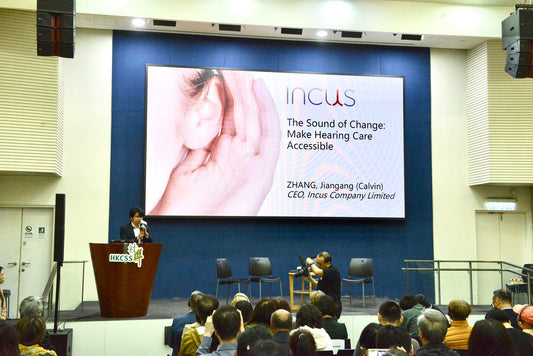
Hearing loss can be hereditary. Hereditary hearing loss means hearing loss caused by genetic mutations passed on from the parents to the child. It is usually already present at birth. Learn more about the most common hereditary disease which impairs both hearing and vision: Usher Syndrome.
What is Usher Syndrome?
The most common symptoms of Usher syndrome (US) involve both hearing and vision problems. It is a hereditary disorder characterized by moderate to severe hearing impairment shortly after birth and progressive loss of vision due to retinitis pigmentosa, a degeneration of the retina that receives images of objects, are characterized by blind spots that begin to appear shortly by midlife.
US was first described by Albrecht Von Graefe in 1858 but was named after Charles Usher, a British eye doctor, who believed that this condition was inherited or passed from parents to their children.
What Causes Usher Syndrome?
Usher syndrome is a hereditary disease. Usher Syndrome is an autosomal recessive disorder. That means that both parents carry mutated genes but do usually not have Usher syndrome themselves. The baby can get either the mutated gene or the normal gene from each parent. A child who inherits a mutated gene from each parent will have Usher Syndrome.
How Does Usher Syndrome Cause Hearing Loss?
Hearing occurs when sound waves travel to the outer hair cells in the organ of Corti, which amplify the vibrations in the inner ear. The inner hair cells convert these vibrations into chemical conductors that activate the auditory nerve and send them to the brain. Hearing loss due to Usher Syndrome is caused by a genetic mutation, which leads to loss of function of the nerve cells in the cochlea (a structure in the inner ear that transmits sound). Eleven mutated pathogenic genes have been found so far.
The Three Types of Usher Syndrome
The three types of US are called US type 1 (US1), US type 2 (US2), and US type 3 (US3). US1 and US2 are the most common types while US3 is relatively rare. Together, US1 and US2 account for approximately 10% of all cases of children who are born deaf.
Usher Syndrome Type 1:
Born with severe hearing loss and consequent balance problems. Visual problems most often begin with difficulty seeing at night but tend to progress rapidly until the individual is completely blind.
Usher Syndrome Type 2:
Born with moderate to severe hearing loss, but do not have balance problems, and the symptoms of retinitis pigmentosa will not appear until the teenage years.
Usher Syndrome Type 3:
Born with normal hearing and normal to near-normal balance, characterized by progressive auditory and visual degradation. Retinitis pigmentosa in the form of night blindness usually begins sometime during puberty. Blind spots appear from the late teenage years to early adulthood. By mid-adulthood, the individual is usually blind.
Summary: The Three Different Types of Usher Syndrome
| Type 1 | Type 2 | Type 3 | |
| Hearing |
Profound hearing loss or deafness at birth
|
Moderate to severe hearing loss at birth
|
Progressive loss in childhood or early teens
|
| Vision |
Decreased night vision by age 10, progressing to severe vision loss by midlife
|
Decreased night vision by adolescence, progressing to severe vision loss by midlife
|
Varies in severity and age of onset; night vision problems often begin in teens and progress to severe vision loss by midlife
|
| Balance (vestibular function) |
Balance problems from birth
|
Normal balance
|
Normal to near-normal balance in childhood; chance of later problems
|
How to Be Diagnosed at an Early Stage?
Early treatment of Usher syndrome requires early diagnosis. The standard diagnosis method is to assess the child's hearing, vision and balance. Audiological tests determine the level and type of hearing loss. A series of eye tests are usually done:
- Visual field test: Measures peripheral vision
- Electroretinogram: Makes a localized diagnosis for retinopathy
- Optical coherence tomography: Captures high-quality images of the retina and is helpful for assessing macular cystic changes.
Balance is tested through videonystagmography. The test measures involuntary eye movements, which might be a symptom of a balance problem.
Genetic testing might also be completed to test for genetic mutations known to be related to the disease. However, because genetic testing could be expensive and will not guarantee a comprehensive examination, it is usually not done.
Is There a Cure for Usher Syndrome?
There is no cure for Usher syndrome. However, many researchers are optimistic about the prospects of finding a cure. Several research projects are ongoing, such as disease mechanisms and gene therapy by Gwenaelle Geleoc in 2017. The study aimed to create normal DNA to replace the DNA which produces defective protein. Such studies have offered glimmers of hope that we could cure Usher syndrome in the future.
Experts encourage early diagnosis and implementation of treatment strategies based on the needs of the child. For example:
- Assistive listening devices: hearing aids or cochlear implants
- Listening and language skills training: oral or sign language, help them to establish a communication method
- Independent Living training: suitable for children with vision loss or balance deficits; help them to combine with multi-sensory functions, construct their mental map to act independently.



